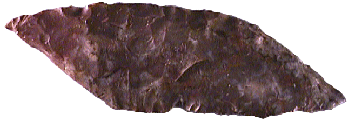

Point Type: HARAHEY
KNIFE a.k.a.
"Four Beveled Knife", "Plains Knife",
"Four-Edged Biface"
Also See: Lerma,
Ramey Knife, Snake Creek
Location: Midwestern United States
Associated Dates:
700 - 350 B.P. - Mississippian
Morphology: Lanceolate
General Description: The Harahey or "Four Beveled Knife" is a large sized, long, ovoid, double pointed form that is usually beveled on one side of each blade face. The cross section is usually rhomboid. The widest point is usually at the mid-section. The shape is ovoid when new and then acquires alternate face bevels on the blade when reworked and sharpened several times. Alternating faces are sharpened equally until the form takes on a propeller or diamond shape and then eventually becomes too narrow for further use as a knife.
The type is commonly found in the eastern southern Plains states of Iowa, western Missouri, western Arkansas, Texas, Oklahoma, New Mexico, Colorado, Kansas and Nebraska. Harahey was the name of a Native American village in Kansas, sought out by the Coronado Expedition of 1541. This knife form was in general use at that time. The Harahey was made by a variety of Plains Indian cultures, some having Caddoan affiliations.
This knife form was often made of Alibates chalcedony or fine grained quartzites, Kay County chert, Knife River chalcedony and various other local cherts.
About the Point Above: The bi-pointed Harahey knife pictured at the top of this page was found in Texas and is made from a dark purple and bluish Alibates chalcedony. Overall, the point measures 90 mm in length from point to point. It is 27 mm wide at mid blade and is 8 mm thick. The blade is beveled on each alternate face. Catalog Number 116-85-D
References: Overstreet, Perino (1), Tully, Turner & Hester, Waldorf
© Copyright 1997 - 2008 LITHICS-Net WWW.LITHICSNET.COM
Use your Browser's BACK Button to return to the LITHICS-Net Index.